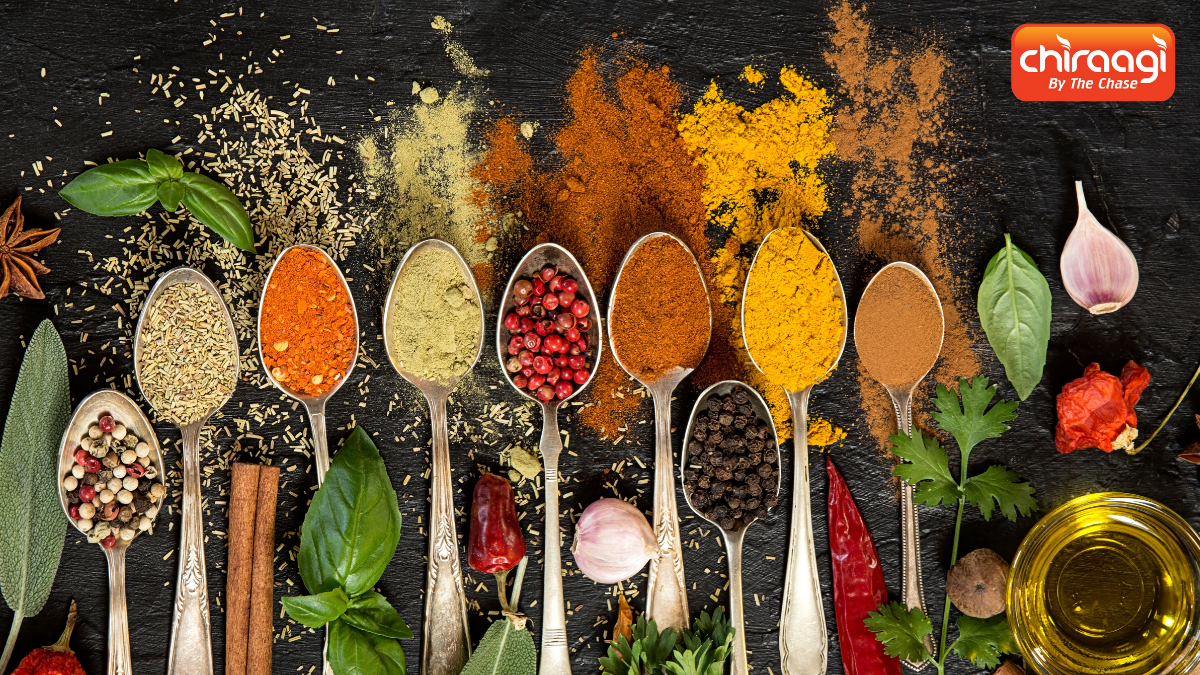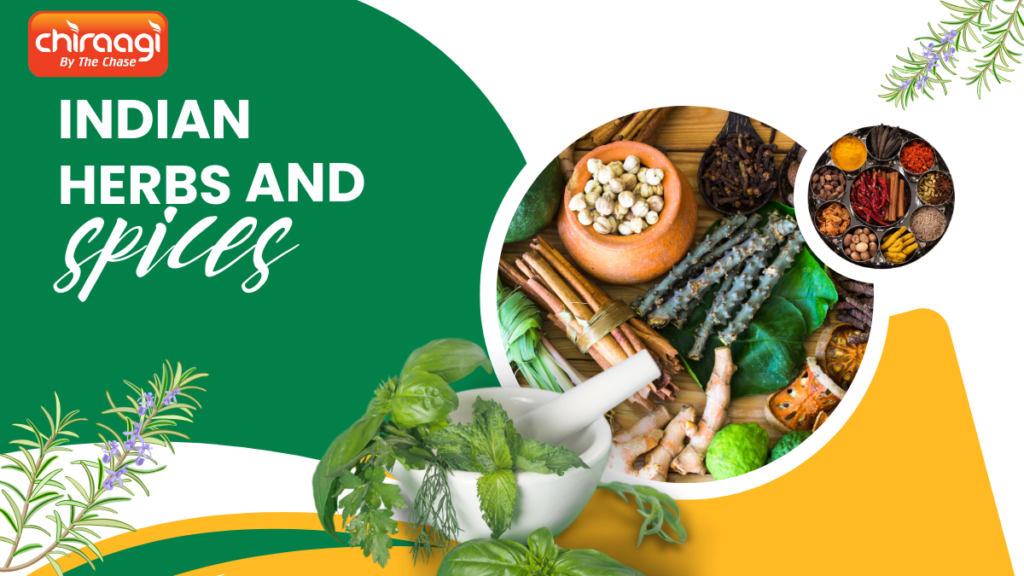Introduction to Indian Herbs and Spices
Indian cuisine’s complex tapestry owes much of its flavor and scent to the region’s many Indian herbs and spices. Indian cuisine is a symphony of spices, with each herb and spice contributing its own note to the overall flavor. For ages, these items have been central to not only culinary traditions, but also cultural ceremonies, medicinal practices, and even commerce networks that connected the ancient globe. Indian herbs and spices are known for their diversity, balancing heat with sweetness, bitterness with pungency, and sharpness with softness. They are the essence of what makes Indian cuisine unique and memorable.
Key Indian herbs and spices and Their Uses
1. Turmeric (Haldi)
Turmeric is one of the most popular spices in Indian cooking. For ages, this root-based spice has been a staple of Indian cuisine, distinguished by its vivid yellow hue. Not only does it provide a warm, earthy flavor to foods, but it also has powerful health benefits because of its active element, curcumin.
- Uses: Turmeric, which appears in almost every curry, is also used in soups, rice dishes, and beverages such as turmeric milk or tea. It is commonly combined with other spices to form the foundation of sophisticated Indian recipes.
- Health Benefits: Turmeric, known for its anti-inflammatory and antioxidant properties, is extensively used in Ayurveda to treat a number of diseases, including digestive issues and joint discomfort.
2. Cumin (Jeera)
Cumin is an essential spice in Indian cuisine. Its earthy, warm flavor serves as the foundation for innumerable cuisines. Cumin, which is often used whole or ground, provides richness and complexity to vegetarian and meat-based dishes.
- Uses: Cumin seeds are commonly used in tempering (known as tadka), which involves frying them in hot oil to unleash their aroma before adding other ingredients. Ground cumin is commonly found in spice combinations such as garam masala and chana masala.
- Health Benefits: Cumin improves digestion, boosts the immune system, and is high in iron, making it a popular spice for improving general health.
3. Coriander (Dhania)
Coriander, in both seed and fresh leaf form, is commonly used in Indian cuisine. The seeds are lemony and slightly sweet, making a nice contrast to heavier spices like cumin or chili powder.
- Uses: Ground coriander seeds are commonly used in spice rubs, stews, and sauces. The leaves, commonly known as cilantro, are garnished or combined into chutneys and sauces.
- Health Benefits: Coriander is high in antioxidants, which aid digestion and blood sugar management.
4. Cardamom (Elaichi)
Cardamom, sometimes known as the “queen of spices,” is an essential element in both sweet and savory Indian cuisine. The green variety has a pleasant, floral aroma, whilst the black cardamom has a smokier, more powerful flavor.
- Uses: Cardamom is used in traditional meals like biryani, as well as desserts like kheer and halwa. It is also a key ingredient in masala chai, a spiced tea popular throughout India.
- Health Benefits: Cardamom, known for its digestive characteristics, is commonly chewed after meals to freshen breath and relieve indigestion.
5. Cloves (Laung)
Cloves are a strong spice with a warm, sweet flavor that is commonly used whole in rice dishes or minced into spice blends. Cloves have a powerful scent, making them great for adding depth to slow-cooked foods.
- Uses: Cloves are commonly used in spice combinations such as garam masala. They are also used whole in recipes such as pulao and biryani, providing a distinct flavor to the rice.
- Health Benefits: Cloves have antibacterial and anti-inflammatory characteristics, and they are commonly used in homemade medicines for toothaches and respiratory problems.
6. Black Pepper (Kali Mirch)
Black pepper has long been known as the “king of spices” due to its historical importance in the spice trade. Its strong, stinging flavor and pungent scent make it an essential ingredient in Indian cuisine.
- Uses: Black pepper is used whole in spice blends or ground to sprinkle over curries, soups, and salads. It improves the flavor of many meals without overpowering them.
- Health Benefits: Black pepper contains piperine, which improves nutrient absorption and functions as an antioxidant.
7. Mustard Seeds (Rai)
Mustard seeds are small but very flavorful. When tempered in heated oil, they produce a nutty, somewhat spicy flavor that compliments the overall flavor of the dish.
- Uses: Mustard seeds are used in curries, pickles, and to temper meals like dal and sabzi. They are also an important element in mustard oil, which is used for cooking in several Indian states.
- Health Benefits: Mustard seeds are beneficial to the heart, contain selenium, and have anti-inflammatory qualities.
8. Fenugreek (Methi)
Fenugreek seeds and leaves are commonly used in Indian cookery. The seeds are slightly bitter, but the leaves, known as kasuri methi, are aromatic and provide a particular flavor to curries and bread.
- Uses: Fenugreek is frequently used in meals such as butter chicken, lentil curries, and parathas. The seeds are frequently roasted to decrease their bitterness.
- Health Benefits: Fenugreek is reported to help regulate blood sugar levels, encourage lactation in nursing moms, and ease digestion.
Indian herbs and spices and Their Uses

1. Curry Leaves (Kadi Patta)
Curry leaves are a mainstay in South Indian cuisine. These aromatic leaves impart a distinct, slightly bitter flavor to meals and are commonly employed in tempering.
- Uses: Curry leaves are often fried in oil with mustard seeds and cumin to make the base for meals like sambar, rasam, and different stir-fries.
- Health Benefits: They are well-known for their anti-diabetic qualities and are used in Ayurveda to alleviate symptoms such as diarrhea and nausea.
2. Mint (Pudina)
Mint is commonly used in Indian cuisine, especially in Northern India. The fresh, refreshing flavor of mint brightens spicy and heavier foods.
- Uses: Green chutney, which is served as an addition to snacks and meals, is made primarily with mint. It is also used in drinks such as lassi and pani puri.
- Health Benefits: Mint is recognized for its digestive and cooling qualities. It is commonly used in herbal teas to treat indigestion and nausea.
3. Holy Basil (Tulsi)
Tulsi is revered in Hindu households across India. It is an essential herb in religious rites, as well as in Ayurvedic medicine.
- Uses: Tulsi is commonly used as a tea or in herbal treatments to alleviate respiratory issues, fevers, and stress.
- Health Benefits: Tulsi is known for its anti-inflammatory, antimicrobial, and adaptogenic characteristics, which help the body deal with stress.
4. Cilantro (Dhaniya Patta)
Fresh cilantro leaves, also called dhaniya patta, are commonly used in Indian cuisine to impart a vibrant, citrusy flavor to dishes.
- Uses: Cilantro is used as a garnish on curries, salads, and chaats. It is also added to chutneys and marinades.
- Health Benefits: Cilantro improves digestion, detoxifies the body, and contains anti-inflammatory qualities.
Conclusion
Indian herbs and spices are an essential component of the country’s culinary tradition. From the vivid color of turmeric to the biting bite of black pepper, these ingredients form the foundation of Indian cuisine. Their unique blend of flavors, fragrances, and health benefits make them vital in both traditional and modern cuisine.
Whether you want to make an authentic Indian dinner or learn about the health advantages of Indian herbs and spices, learning their application will improve your cooking skills. These ingredients provide a unique blend of flavor, history, and health, ensuring that Indian food remains one of the world’s most popular and appreciated dishes.
Also Read:- All Indian Spices A Complete Guide


